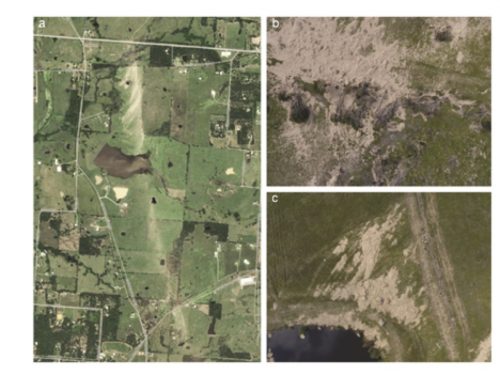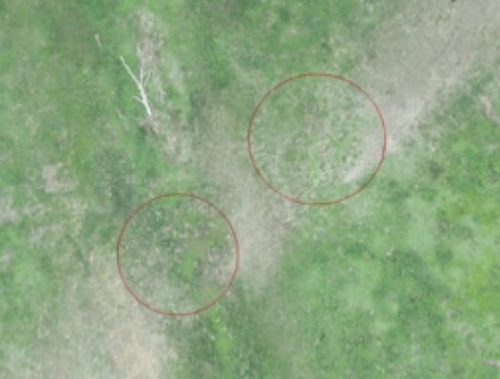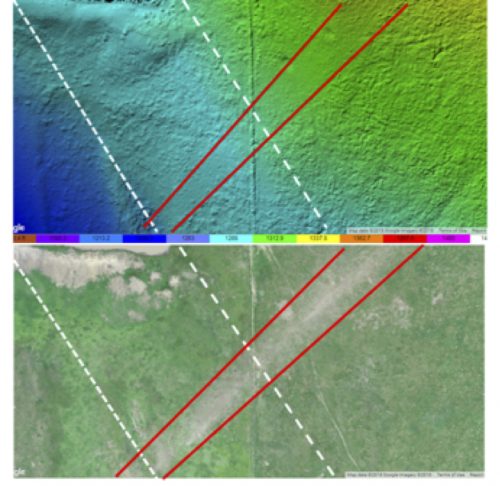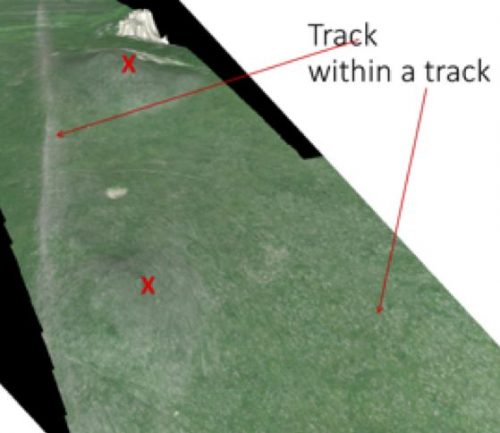Planetary, synoptic, meso-alpha, meso-beta, local, and more—there are atmospheric scales aplenty discussed at AMS meetings. Enter microtopography, a once-rare word increasingly appearing in the mix in research (for example, here and here).
The word is also coming up as researchers are getting new tools to examine the interaction of tornadoes with their immediate surroundings. Microtopography looks like a potential factor in tornadic damage and in the tornadoes themselves, according to an AMS Annual Meeting presentation by Melissa Wagner (Arizona State Univ.) and Robert Doe (Univ. of Liverpool), who are working on this research with Aaron Johnson (National Weather Service) and Randy Cerveny (Arizona State Univ). Their findings relate tornado damage imagery to small changes in local topography thanks to the use of unmanned aerial systems (UASs).
Microtopographic interactions of tornadic winds were captured in their UAS imagery. Here’s the 5-meter resolution RapidEye satellite imaging of a 30 April 2017 Canton, Texas, tornado path (panel a) versus higher-resolution UAS imaging:

The UAS surveys show that tornadic winds interact with sunken gullies, which appear as unscarred, green breaks (circled in red) in the track of browned damaged vegetation:

Erosion and scour are limited within the depressed surfaces of the gullies compared to either side. In another section of the track, track width increases with an elevation gain of approximately 74 feet, as shown in a digital elevation model and 2.5 cm resolution UAS imagery:

The advent of unmanned aerial vehicles (UAVs) has opened new windows on tornado damage tracks. Decades ago, damage surveys took a big leap forward with airplane-based photography that provided a perspective difficult to achieve on the ground. Satellites also can provide a rapid overview but in relatively low resolution. UASs fly at 400 feet—and are still limited to line-of-sight control and the logistics of coordinating with local emergency and relief efforts, regulatory and legal limitations, not to mention still-improving battery technology.
However, UASs provide a stable, reliable aerial platform that benefits from high-resolution imaging and can discern features on the order of centimeters across. Wagner and colleagues were using three vehicles with a combined multispectral imaging capability that is especially useful in detecting changes in the health of vegetation. As a result their methods are being tested primarily in rural, often inaccessible areas of damage.
UAS technologies thus can capture evidence of multi-vortex tornadoes in undeveloped or otherwise remote, vegetated land. The image below shows a swath with enhanced surface scour over two hills (marked X). The arrow on the right identifies speckled white surface erosion, part of the main tornado wedge. Such imagery explains why, among other research purposes, Wagner and Doe are developing the use of UASs in defining tracks and refining intensity-scale estimates.

AMS
Dr. Wakimoto’s Lessons in Leadership
“One of you is likely to be standing here someday replacing me, “ AMS President Roger Wakimoto told the assembled 600+ attendees of the 18th AMS Student Conference Saturday morning in Phoenix.
The students looked at each other in the North Ballroom, but nobody could figure out who he was talking about. And neither could Dr. Wakimoto.
“Everyone is capable of being a leader,” he explained. “It’s whether or not you want to grasp the opportunity.”
For Wakimoto, who now serves as Vice-Chancellor for Research at the UCLA, this is wisdom grasped from life experience.
“As a student I was never chosen to lead anything,” the famed severe storm researcher told the students. “When they selected basketball teams, I was always the last person they would have selected.”
But at key moments in his life, enough people recognized Wakimoto’s capabilities even when he did not. Wakimoto didn’t plan to go to graduate school, but a professor “yanked me aside and told me it would be an incredible waste if I didn’t.”
Then, while comfortable in the academic enclave of his research at UCLA, people pushed him to try a leadership role, first at NCAR and then the National Science Foundation.
Wakimoto, who had to step suddenly into a now-finished two-year tenure as AMS President with the death of Matthew Parker, expressed the lessons of leadership in three simple words: transparency, integrity, and engagement.
The rest is unpredictable. “Forecasting the weather is easy; forecasting your future is impossible.”
Dr. Wakimoto's Lessons in Leadership
“One of you is likely to be standing here someday replacing me, “ AMS President Roger Wakimoto told the assembled 600+ attendees of the 18th AMS Student Conference Saturday morning in Phoenix.
The students looked at each other in the North Ballroom, but nobody could figure out who he was talking about. And neither could Dr. Wakimoto.
“Everyone is capable of being a leader,” he explained. “It’s whether or not you want to grasp the opportunity.”
For Wakimoto, who now serves as Vice-Chancellor for Research at the UCLA, this is wisdom grasped from life experience.
“As a student I was never chosen to lead anything,” the famed severe storm researcher told the students. “When they selected basketball teams, I was always the last person they would have selected.”
But at key moments in his life, enough people recognized Wakimoto’s capabilities even when he did not. Wakimoto didn’t plan to go to graduate school, but a professor “yanked me aside and told me it would be an incredible waste if I didn’t.”
Then, while comfortable in the academic enclave of his research at UCLA, people pushed him to try a leadership role, first at NCAR and then the National Science Foundation.
Wakimoto, who had to step suddenly into a now-finished two-year tenure as AMS President with the death of Matthew Parker, expressed the lessons of leadership in three simple words: transparency, integrity, and engagement.
The rest is unpredictable. “Forecasting the weather is easy; forecasting your future is impossible.”
AMS Council Speaks Out on Federal Government Shutdown
At its meeting this morning in Phoenix, the AMS Council has released the following statement on the Federal government’s ongoing shutdown:
Those of us who study and predict the atmosphere are familiar with the impacts of uncertainty. Americans rely on weather forecasts, and they trust them to be reliable. Lives and livelihoods are saved or lost based on the timeliness and accuracy of a single weather warning.
Unfortunately, the current U.S. government shutdown—and the associated uncertainty—is now beginning to seriously set back efforts to better understand and forecast our environment and protect the nation’s health and prosperity. National Weather Service forecasters who work without pay during a shutdown, like their peers in other essential government services, experience mounting financial and emotional stress. Years of research are jeopardized when federal scientists cannot collect uninterrupted data. When government researchers no longer maintain collaborations with their peers in academia and industry, our nation, and each and every citizen, loses out.
The uncertain length of a shutdown adds to its costly and corrosive effects. Like a chain reaction, the impacts of a government shutdown ripple far beyond those who are furloughed and can impede development of new scientific technologies that are vital to our nation. Many non-government contract employees are already on forced time off without pay, and experiencing severe financial and personal hardship; we may lose the benefit of their knowledge and capabilities as a result.
Within days, the current shutdown may become the nation’s longest on record. Virtually all other nations have mechanisms to keep partisan disagreements from closing major segments of their governments for days or weeks. Without such a backstop, every shutdown means that the U.S. loses more ground to overseas competitors, as other nations take the lead in scientific leadership.
Our nation cannot afford to undermine its scientific enterprise for the sake of policy disagreement. The AMS urges our elected officials to come together and restore normal federal government operations as soon as possible, and we strongly suggest that partisan differences of opinion be given the time and attention they deserve without the unintended consequences of holding scientific research and related activities hostage.
The AMS Annual Meeting: Always a Need to Hear the Unheard
You’ve been here before. Those previous AMS Annual Meetings, for example, right here in Phoenix. You probably have some good memories of those. But this is not the sense of déjà vu we’re talking about.
Meteorologists, and indeed scientists of many disciplines, bridge the road from societal impacts to societal progress. As a result, you’ve been in this place before: “place” in the sense of what you study, what you say, and what you accomplish. It is all predicated on the premise that the most important people in the room are the people who are not, actually, in the room. The people who flee hurricanes and tsunamis, who dig out from snow and put out wildfires, whose coral reefs are blanching—they are notably absent from conference rooms and auditoriums as well as from laboratories, classrooms, and forecast offices. Yet in the places the work of these atmospheric and related sciences goes on, these unheard voices are the pleas that are being answered.
Science is a process of voices participating in discussions across many divides. Published papers in AMS journals spread ideas from many corners of the globe, just as our Annual Meeting brings together people and their findings from across borders.
As with international borders, so too with generational borders. Discussions in Phoenix this year originate from people who were once among us, but whose voices are now silenced. You can be sure that, as much as it hurts to lose a pioneering scientist such as, say, Doug Lilly, who died this past year, his voice is still very much in the room here due to all his students and all the people influenced by his work. In fact, anyone who takes advantage of opportunities to mentor other scientists is ensuring her voice will be in many rooms she’s never entered. This is the power of a collective enterprise such as AMS.
While answering the unheard is a specialty for this community, now we are about to get even better at it. First, we greatly miss our colleagues and friends from the Federal government who unfortunately must miss this AMS Annual Meeting. The opportunities of the week are reserved for the vast majority who made it to Phoenix as planned. But remember that we are used to speaking as best we can for voices of the missing. The voice we raise, and the waves we make, will undoubtedly be all the stronger if those who aren’t here are not forgotten.
But second, and ultimately more significantly, we will get better at including the voice of the unheard–by including them in the room. One of the great strengths of AMS president Roger Wakimoto’s theme this week is directly related to this chronic condition of sciences so intimately tied to societal need: “Understanding and Building Resilience to Extreme Events by Being Interdisciplinary, International, and Inclusive.”
That last of three “I’s” is telling. Inclusiveness promotes many voices by giving people a seat at the table. No longer can AMS represent every voice by assuming that the few can speak for the many. Inclusiveness is a theme of this meeting, of this year in AMS initiatives, and a pillar of AMS Centennial activities moving forward. For example, this year’s Inez Fung Symposium includes a panel on Tuesday on “Fostering Diverse Perspectives in Climate Science.”
This year’s meeting will be a success, all the more because you’re accustomed to acting like a typical meteorologist, listening to the people who can’t be, or haven’t typically been, in the room.
Raise Your Voice for Science
by Sarah Benish and Rafael Loureiro
Academic institutions are often highly regarded in terms of ground-breaking research, but less commonly for their science-related political engagement. As two scientists in academia, we feel that it is not only our duty to be engaged in scientific political matters but also feel compelled to share our enthusiasm about science policy with our students and peers. We should all have a common goal to communicate science to policymakers, allowing better, science-informed decisions.
Through the Voices for Science program at AGU, we gathered at a two-day workshop in April 2018 with ~25 other scientists to focus on a common goal—how to be influencers in our fields about better communication of science to the general public and policy makers. We were given the opportunity to learn about the latest science policy initiatives and build on our own communication skills, such as practicing requesting that our representatives do something specific, like supporting or opposing a bill or joining a certain caucus (also known as “the ask”). The next day, we actively put these skills in use by meeting with congressional representatives on the Hill.
Since so many of us in the sciences are gathered this week at the AGU conference in Washington, D.C., we hope, by sharing our individual experiences in participating in this year-long program, you may be inspired to engage science policy in your own way, at your own institutions.
Sarah:
I am a fourth-year Ph.D. student in atmospheric and oceanic science at the University of Maryland. I study air pollution production and transport in the North China Plain and have interests in science policy, communication, and research. Originally from Oshkosh, Wisconsin, the home of the Experimental Aircraft Association, I became interested in becoming a scientist after earning my private pilot’s license.
Before Voices for Science, I had never interacted with my elected representatives before. My first experience was when I met with six legislators on the Hill with AGU. I enjoyed telling my story, explaining my research, and discussing the importance of consistent science funding in the congressional budget. Meeting with decision makers as a group was particularly useful at the beginning, especially when bringing up the “ask,” but by the end of the day, I felt confident enough to help lead the conversation to issues that were important to me.
Since meeting with my representatives, I have been regularly communicating with them. For example, when a new study linking air quality and diabetes was released in July, I forwarded the article to my representative who expressed concern about air quality legislation hurting the economy. Additionally, I sent my blog posts about my life as an #actuallivingscientist to my legislators to tell my story in how I became interested in science. I thanked my senator for supporting the Hidden Figures Congressional Gold Medal Act and asked my other senator to co-sponsor the act. However, one of my favorite interactions so far was when my senator’s office called to thank me for sending an op-ed I published in my local newspaper about air quality and health.
AGU and the Voices for Science program has provided me with support throughout this remarkable experience. I realized that many students, like me, had never contacted their congresspeople before and wanted to fill that need. So in September, I hosted a congressional letter writing breakfast at the student union at the University of Maryland. Over free breakfast, students wrote letters about science funding in FY19 to their elected representatives and were given resources and letter writing templates. In total, 40 letters to 8 different states were written including Texas, Wisconsin, Pennsylvania, and Maryland.
I was really excited to see University of Maryland undergraduate and graduate students participate in this event since many had never written their representative before. Students wrote about how basic science impacts their daily lives as well as about important data sources influential in their research. Since the event, participants have told me their representatives contacted them to further discuss science funding. That these letters have started such a conversation is a success to me.
Rafael:
I am a space botanist and currently hold two positions, one as a scientist at Blue Marble Space Institute of Science and an assistant professor at Winston-Salem State University. Quite honestly, I never knew what I wanted to do with my life but I knew that I wanted to make a difference and liked dinosaurs, so biology was the most obvious route. I never knew that dinosaurs would become a distant hobby and that the “making a difference” part would be such a pivotal part of my daily activities.
Through my teaching and research I am able to not only touch lives but also mold minds: minds avidly in search for new, exciting information about life here on Earth and possibly elsewhere in the universe. Minds that are constantly seeking to share knowledge with anyone willing to listen (and let me tell you – they are out there by the buckets full).
Voices for Science allowed me to get better at communicating my science, to tailor my speech to different audiences, from K-12 students to politicians. I have learned that they all want to listen, but it is up to you to take the first step.
Many of my initiatives involved students and my departmental peers. The greatest challenge was to show them that sharing your science with any audience willing listen to you involves adaptation and dialog. Adaptation means tailoring our speech and not try to bury people with data, charts, and super cool statistics that are completely irrelevant to them. Instead, we tell them how our science impacts they daily or future lives. Dialog means learning how to listen to what they have to say, to what it is important to them, and how can we make it important to us.
Policymakers are no different. They want to hear from you, even when your point of view, your research, or that particular budget point that you are asking for him or her to vote for goes against their agenda. The receptiveness so far has been uncanny, especially when students are involved. Students can be a great outlet for many of your professors in academia to use to communicate your science or the importance of science to your representative, your students. Young, passionate minds are among the best tools I have seen for engaging people in science policy initiatives.
Why not serve as a mentor in a Science Policy club? Organize debates between students on matters of budgeting for science. Invite local representatives to tour your institution and have students show them their passion for the science that they are developing (and most of their work is funded by agencies jeopardized by budget cuts). This is one of those opportunities for a handshake and a picture with students and your representative near that cool, very expensive NSF funded microscope—a picture you can resend when an important vote is about to come up.
With all that being said, the most important lesson I have learned from Voices for Science is that anyone can do science policy engagement. Against facts there is little room for debate, but in order to make those facts available we (scientist/students) need to be out there, sharing our science and asking everybody – how can we change this situation together?
If you are passionate about science and thinking about contacting your representatives about it, we encourage you to go for it! Here are a few suggestions:
- Have a goal. Before starting, know what you want to communicate to your elected officials. Have a clear message and a well-defined “ask.” For more information, visit AGU and AMS websites.
- Know your limits. Stay within your area of expertise or knowledge. Do not be afraid to say, “I don’t know.” If you know someone who does know, offer to connect your representative with that person.
- Encourage students. Part of our job as educators and researchers is to challenge each other’s ideas and open the door to new opportunities. Students who are already interested in science policy will partake in opportunities, but others need encouragement (sometimes, just free food) to commit to participating.
- Seek support from professional societies, like AMS. Did you know that AMS hosts a summer policy colloquium? How about the involvement AMS has briefing Capitol Hill? There are also events during the 99th Annual AMS meeting, including town halls with Marcia McNutt, the president of the National Academy of Science, Jim Bridenstine, administrator of NASA, and Bob Riddaway, president of the European Meteorological Society.
- They want to hear from you. Share your science with your local representative, either by sending him/her your latest research paper with a short commentary in layman language or inviting them to come see your lab. Your representatives need to be aware of the cool science you are doing.
Your AMS Community Online
by Jordan Stillman, AMS Community Coordinator
After a successful soft launch to AMS board and committee members this past winter, the AMS will be opening up our new online platform, AMS Community, to all AMS members as a new member benefit this May.
The goal of the AMS Community is to enhance communication and improve member engagement. We want to give our members a place to network, communicate, and collaborate, where members can reach out to their colleagues and peers to discuss what’s really important to them, from actual challenges they’re facing in their work to greater issues affecting the weather, water, and climate community. We envision a space where members can troubleshoot problems, solicit advice, seek feedback, and share with one another, creating a vast and thriving pool of communal knowledge.
Those involved in the Community will be the first to know about new AMS resources, like webinars, podcasts, briefings, conferences, and centennial activities. Simultaneously, the Community will also provide improved methods and transparency for connecting with AMS staff and allow volunteers and staff to make members aware of the various opportunities for greater engagement (for example, in policy issues, in local or regional educational opportunities, in statements, in committees, and so on). Already, this new tool is allowing for improved communication among boards and committees and will leave room for even more possibilities with the full member launch.
An intuitive platform, AMS Community includes an easy-to-use discussion board, resource library, and a comprehensive member directory as well as the administrator ability to post announcements and events for the use of all membership. Community members can be tagged with the @mentions functionality (just like Twitter!), participate in discussions, and upload and download useful documents, files, and other handy resources. All active AMS members will automatically be subscribed to the AMS Community and begin receiving notifications once we launch, allowing them to immediately engage with their colleagues at any time, from any location. No need to wait until the next conference!
Keith Seitter described the AMS Community in his January 2018 letter in BAMS, and he sums it up perfectly: “As powerful as this new technology can be, it is really just a tool to connect people. And that is what AMS has always been about—fostering connections among members to serve the broader community and support our science and services. We are all very excited to take those connections—and with them our members’ success—to new levels.”